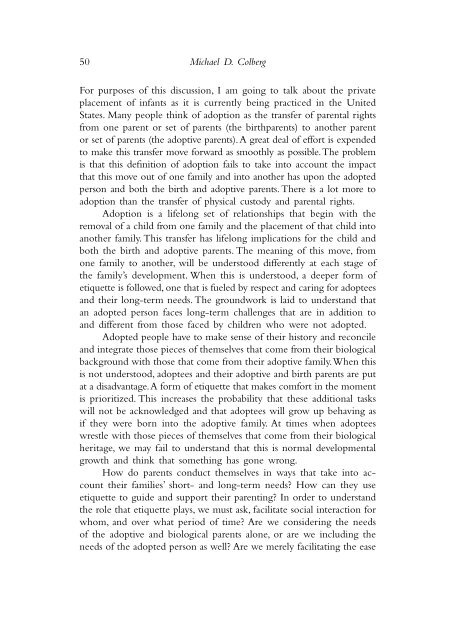Create successful ePaper yourself
Turn your PDF publications into a flip-book with our unique Google optimized e-Paper software.
50 Michael D. Colberg<br />
For purposes <strong>of</strong> this discussion, I am going to talk about <strong>the</strong> private<br />
placement <strong>of</strong> infants as it is currently being practiced in <strong>the</strong> United<br />
States. Many people think <strong>of</strong> adoption as <strong>the</strong> transfer <strong>of</strong> parental rights<br />
from one parent or set <strong>of</strong> parents (<strong>the</strong> birthparents) to ano<strong>the</strong>r parent<br />
or set <strong>of</strong> parents (<strong>the</strong> adoptive parents). A great deal <strong>of</strong> effort is expended<br />
to make this transfer move forward as smoothly as possible. The problem<br />
is that this definition <strong>of</strong> adoption fails to take into account <strong>the</strong> impact<br />
that this move out <strong>of</strong> one family and into ano<strong>the</strong>r has upon <strong>the</strong> adopted<br />
person and both <strong>the</strong> birth and adoptive parents. There is a lot more to<br />
adoption than <strong>the</strong> transfer <strong>of</strong> physical custody and parental rights.<br />
Adoption is a lifelong set <strong>of</strong> relationships that begin with <strong>the</strong><br />
removal <strong>of</strong> a child from one family and <strong>the</strong> placement <strong>of</strong> that child into<br />
ano<strong>the</strong>r family. This transfer has lifelong implications for <strong>the</strong> child and<br />
both <strong>the</strong> birth and adoptive parents. The meaning <strong>of</strong> this move, from<br />
one family to ano<strong>the</strong>r, will be understood differently at each stage <strong>of</strong><br />
<strong>the</strong> family’s development. When this is understood, a deeper form <strong>of</strong><br />
etiquette is followed, one that is fueled by respect and caring for adoptees<br />
and <strong>the</strong>ir long-term needs. The groundwork is laid to understand that<br />
an adopted person faces long-term challenges that are in addition to<br />
and different from those faced by children who were not adopted.<br />
Adopted people have to make sense <strong>of</strong> <strong>the</strong>ir history and reconcile<br />
and integrate those pieces <strong>of</strong> <strong>the</strong>mselves that come from <strong>the</strong>ir biological<br />
background with those that come from <strong>the</strong>ir adoptive family. When this<br />
is not understood, adoptees and <strong>the</strong>ir adoptive and birth parents are put<br />
at a disadvantage. A form <strong>of</strong> etiquette that makes comfort in <strong>the</strong> moment<br />
is prioritized. This increases <strong>the</strong> probability that <strong>the</strong>se additional tasks<br />
will not be acknowledged and that adoptees will grow up behaving as<br />
if <strong>the</strong>y were born into <strong>the</strong> adoptive family. At times when adoptees<br />
wrestle with those pieces <strong>of</strong> <strong>the</strong>mselves that come from <strong>the</strong>ir biological<br />
heritage, we may fail to understand that this is normal developmental<br />
growth and think that something has gone wrong.<br />
How do parents conduct <strong>the</strong>mselves in ways that take into account<br />
<strong>the</strong>ir families’ short- and long-term needs? How can <strong>the</strong>y use<br />
etiquette to guide and support <strong>the</strong>ir parenting? In order to understand<br />
<strong>the</strong> role that etiquette plays, we must ask, facilitate social interaction for<br />
whom, and over what period <strong>of</strong> time? Are we considering <strong>the</strong> needs<br />
<strong>of</strong> <strong>the</strong> adoptive and biological parents alone, or are we including <strong>the</strong><br />
needs <strong>of</strong> <strong>the</strong> adopted person as well? Are we merely facilitating <strong>the</strong> ease
















